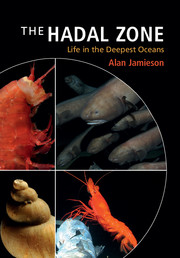Book contents
- Frontmatter
- Dedication
- Contents
- Preface
- Acknowledgements
- Part I History, geology and technology
- Part II Environmental conditions and physiological adaptations
- 4 The hadal environment
- 5 Hydrostatic pressure
- 6 Food supply to the trenches
- Part III The hadal community
- Part IV Patterns and current perspectives
- Appendix
- References
- Index
- Plate section
6 - Food supply to the trenches
from Part II - Environmental conditions and physiological adaptations
Published online by Cambridge University Press: 05 February 2015
- Frontmatter
- Dedication
- Contents
- Preface
- Acknowledgements
- Part I History, geology and technology
- Part II Environmental conditions and physiological adaptations
- 4 The hadal environment
- 5 Hydrostatic pressure
- 6 Food supply to the trenches
- Part III The hadal community
- Part IV Patterns and current perspectives
- Appendix
- References
- Index
- Plate section
Summary
In addition to hydrological and geological factors, food supply has an incredibly strong spatial and temporal influence on species composition and abundance (Gage, 2003). The deep sea, including the hadal zone, is essentially a heterotrophic environment where most of the available food descends from the ocean surface waters (Tyler, 1995). Surface-derived food (allochthonous) ranges in size, from particulate organic matter (POM), the carcasses of gelatinous organisms, fish and even dead whales (e.g. Britton and Morton, 1994; Beaulieu, 2002; Smith and Baco, 2003; Robison et al., 2005, respectively) to terrestrial plant and wood debris (Turner, 1973; Wolff, 1976). Supplementary energy is available, however, in the form of autochthonous production from the hydrothermal vents and cold seeps found in the deep sea (Childress and Fisher, 1992).
Although the food sources and types of food found in the hadal zone are very similar to those of the general deep sea, ‘hadal’ food differs in that the distance travelled by surface-derived nutrition to hadal depths is formidable and, as a result, both the quantity and quality of the food is likely to be reduced. Furthermore, the trenches are of a unique topographical setting where food distribution is different to that of the flat neighbouring abyssal plains. Moreover, when coupled with the periodic seismic-induced sediment slides, the food distribution factor is central to the creation of this unique setting in which the deepest of deep-sea organisms survive. The other key factor to point out when considering food supply to the trenches is that, due to isolation, there is little resource gradient between different trenches; they are, after all, a disjunct collection of deep trenches with often very different biogeographical settings. Thus, the food availability, in terms of both type and quantity, may differ from one trench to another.
- Type
- Chapter
- Information
- The Hadal ZoneLife in the Deepest Oceans, pp. 109 - 124Publisher: Cambridge University PressPrint publication year: 2015



